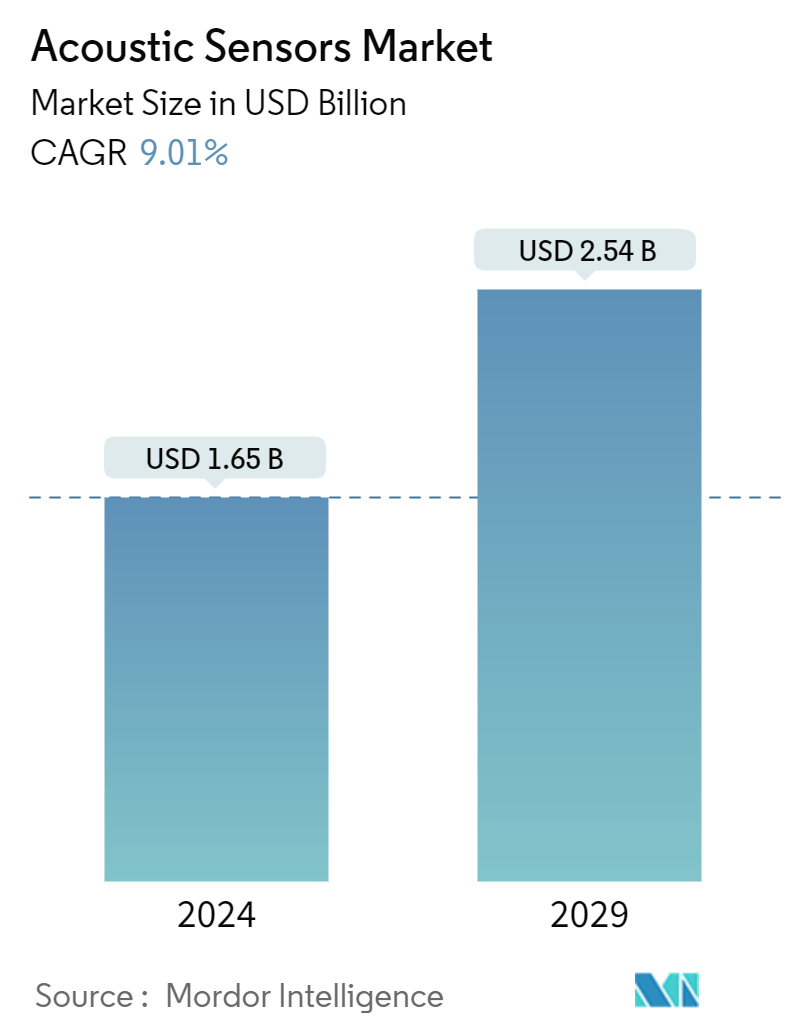Market Size of Acoustic Sensors Industry

| Study Period | 2022 - 2029 |
| Market Size (2024) | USD 1.65 Billion |
| Market Size (2029) | USD 2.54 Billion |
| CAGR (2024 - 2029) | 9.01 % |
| Fastest Growing Market | Asia Pacific |
| Largest Market | North America |
| Market Concentration | Low |
Major Players
*Disclaimer: Major Players sorted in no particular order |
Acoustic Sensors Market Analysis
The Acoustic Sensors Market size is estimated at USD 1.65 billion in 2024, and is expected to reach USD 2.54 billion by 2029, at a CAGR of 9.01% during the forecast period (2024-2029).
- Most people use camera-based sensing. Research has focused on RF-based approaches for their ease and lack of intrusion. Because RFID doesn't require batteries, it is frequently used in corporate operations like supply chain management and storage. Furthermore, WiFi-based sensing approaches have been shown to be quite effective in integrating sensing functions in a smart home or workplace due to the widespread availability of indoor WiFi infrastructures.
- Acoustic signals offer a third dimension for sensing in addition to camera- and RF-based solutions since microphones and speakers are increasingly often found in mobile, wearable, and smart appliance devices. For noise reduction and far-field speech pickup, the Galaxy Note 3 and Amazon Echo include numerous sophisticated microphones built into them. Both the Galaxy S9 and Google Home have multiple stereo speakers. Additionally, many mobile devices now offer high recording quality (such as 192 kHz) aimed at audiophiles, which has significantly improved acoustic-based detection capabilities.
- Furthermore, advancement in the communication industry is boosting the overall acoustic sensor market. According to GSMA, As of January 2024, 47 operators have rolled out commercial 5G services on Standalone (SA) networks. Additionally, over half of these operators anticipate implementing 5G-Advanced within a year of its standard release. The surge in 5G SA and 5G-Advanced initiatives in 2024 is poised to catalyze a fresh wave of 5G investments, particularly in leading markets.
- Moreover, acoustic sensors have recently seen significant demand in automotive applications. The complete silence of the motors used in EVs may pose a hazard to inattentive pedestrians. As a result, the latest electric and hybrid cars will have to be equipped with an acoustic warning system. Therefore, rising concerns regarding traffic management will drive market growth. According to UBS, the global market for sensor semiconductors in autonomous vehicles is anticipated to reach USD 30 billion by 2030. Changes in automotive trends may lead to potential growth for acoustic sensors for automotive applications during the forecast period.
- Various companies are investing in Acoustic sensors due to their deployment in smart devices that can be used in diverse fields like environmental monitoring of toxic and hazardous vapors in defense applications, food analysis and control, engine oil aging, microorganism, and healthcare applications like cancer cell detection. For instance, in In July 2024, Tesla unveiled its intentions to introduce an automated ride-hailing service, contingent on resolving self-driving technology. Tesla's patent details a sophisticated sensor array, encompassing image, acoustic, thermal, pressure, capacitive, radio frequency, and gas sensors, to monitor the vehicle's interior environment. such instances are creating the demand for acoustic sensors from automotive industry.
- There are many technical challenges associated with acoustic sensors, such as annoying audible sound leakage and large power consumption, which can relatively reduce the battery life of battery-powered devices, and the acoustic sensing system can affect the music play and voice calls.
- Furthermore, the ongoing political pus and downs are expected to impact the electronics industry significantly. The conflict has already exacerbated the semiconductor supply chain issues and the chip shortage that have affected the industry for some time. The disruption may come in the form of volatile pricing for critical raw materials such as nickel, palladium, copper, titanium, aluminum, and iron ore, resulting in material shortages. This would obstruct the manufacturing of acoustic sensors.
Acoustic Sensors Industry Segmentation
Acoustic sensors provide a signal by rapidly shifting a diaphragm back and forth, which causes the air surrounding the diaphragm to be displaced and produces an acoustic wave. Typically, ultrasonic frequencies are used by acoustic distance sensors. The studied market is segmented by Wired and Wireless types in Surface Wave and Bulk Wave types. Further, the market is segmented by sensing parameters such as Temperature, Pressure, and Torque among various applications such as Automotive, Aerospace & Defense, Consumer Electronics, Healthcare, and Industrial in multiple geographies. The impact of macroeconomic trends on the market is also covered under the scope of the study. Further, the disturbance of the factors affecting the market's evolution in the near future has been covered in the study regarding drivers and constraints. The market sizes and predictions are provided in terms of value in USD for all the above segments.
| By Type | |
| Wired | |
| Wireless |
| By Wave Type | |
| Surface Wave | |
| Bulk Wave |
| By Sensing Parameter | |
| Temperature | |
| Pressure | |
| Torque |
| By Application | |
| Automotive | |
| Aerospace & Defense | |
| Consumer Electronics | |
| Healthcare | |
| Industrial | |
| Other Applications |
| By Geography | |
| North America | |
| Europe | |
| Asia Pacific | |
| Latin America | |
| Middle East & Africa |
Acoustic Sensors Market Size Summary
The acoustic sensor market is poised for significant expansion, driven by advancements in surface wave acoustic sensor technology, which is increasingly utilized in telecommunications, aerospace, and automotive sectors. These sensors are integral to radio frequency applications, serving as essential components in satellite communication terminals and base stations. The automotive industry, particularly with the rise of electric and hybrid vehicles, is witnessing a surge in demand for acoustic sensors to enhance pedestrian safety through acoustic warning systems. The advent of 5G technology presents a substantial opportunity for market growth, as the demand for high-performance, cost-effective SAW filters in mobile devices escalates. The consumer electronics sector, especially smartphones and laptops, remains a major consumer of acoustic sensors, with the widespread adoption of these sensors contributing to reduced costs and enhanced device performance.
Regionally, the Asia Pacific is expected to lead the market growth, followed by North America and Europe, due to the increasing application of acoustic sensors in consumer electronics like smartphones and smartwatches. The region's investment in 5G infrastructure is anticipated to further boost the demand for RF semiconductors. The market is characterized by high fragmentation, with numerous global and local manufacturers competing, which has led to price reductions and narrow profit margins. Innovations in MEMS technology and strategic partnerships are key strategies for companies to maintain competitiveness. Recent developments, such as the integration of acoustic sensors in maritime and robotic applications, highlight the ongoing advancements and diverse applications of acoustic sensor technology across various industries.
Acoustic Sensors Market Size - Table of Contents
-
1. MARKET INSIGHTS
-
1.1 Market Overview
-
1.2 Industry Attractiveness - Porter's Five Forces Analysis
-
1.2.1 Bargaining Power of Suppliers
-
1.2.2 Bargaining Power of Buyers
-
1.2.3 Threat of New Entrants
-
1.2.4 Intensity of Competitive Rivalry
-
1.2.5 Threat of Substitute Products
-
-
1.3 Industry Value Chain Analysis
-
1.4 Assessment of Impact of Macroeconomic Trends on the Market
-
-
2. MARKET SEGMENTATION
-
2.1 By Type
-
2.1.1 Wired
-
2.1.2 Wireless
-
-
2.2 By Wave Type
-
2.2.1 Surface Wave
-
2.2.2 Bulk Wave
-
-
2.3 By Sensing Parameter
-
2.3.1 Temperature
-
2.3.2 Pressure
-
2.3.3 Torque
-
-
2.4 By Application
-
2.4.1 Automotive
-
2.4.2 Aerospace & Defense
-
2.4.3 Consumer Electronics
-
2.4.4 Healthcare
-
2.4.5 Industrial
-
2.4.6 Other Applications
-
-
2.5 By Geography
-
2.5.1 North America
-
2.5.2 Europe
-
2.5.3 Asia Pacific
-
2.5.4 Latin America
-
2.5.5 Middle East & Africa
-
-
Acoustic Sensors Market Size FAQs
How big is the Acoustic Sensors Market?
The Acoustic Sensors Market size is expected to reach USD 1.65 billion in 2024 and grow at a CAGR of 9.01% to reach USD 2.54 billion by 2029.
What is the current Acoustic Sensors Market size?
In 2024, the Acoustic Sensors Market size is expected to reach USD 1.65 billion.

